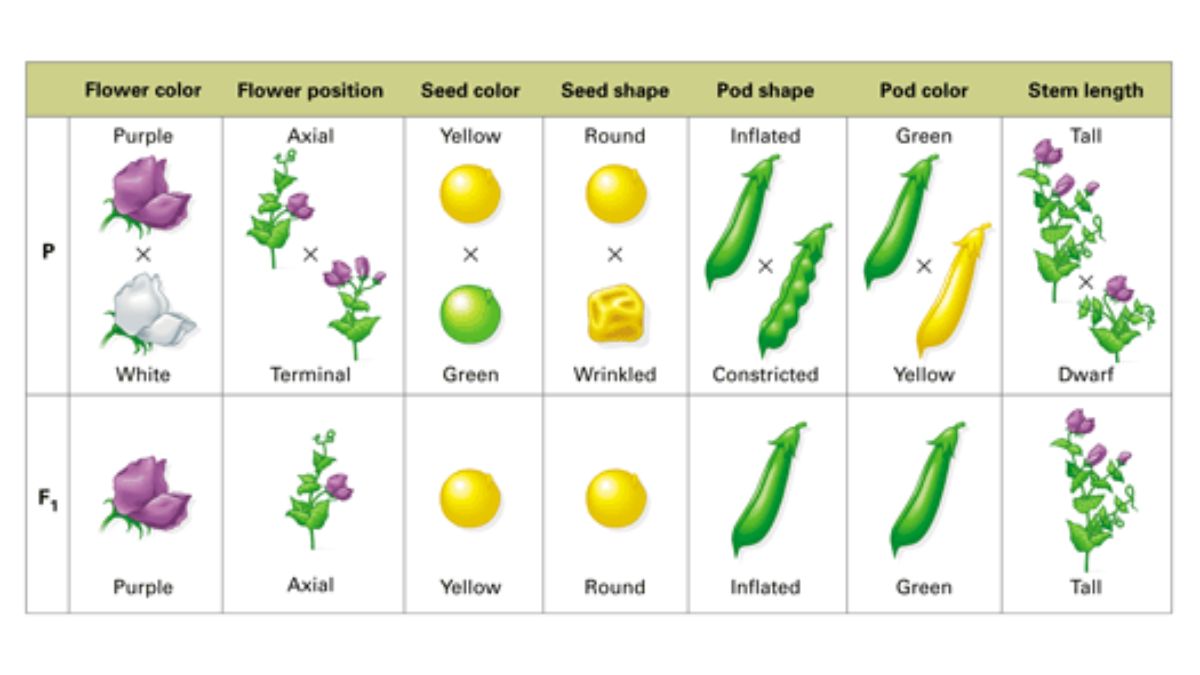The National Eligibility cum Entrance Test for admission into medical courses like MBBS and BDS is to be conducted by the National Testing Agency at various exam centers across the nation in May 2026. The exam will test student’s understanding and knowledge of various important chapters and topics of Physics, Chemistry, and Biology subjects. One such chapter that every student needs to study in order to score well in the exam is the Principles of Inheritance and Variation; therefore, in this chapter, we have shared the NEET Notes for the Chapter Principles of Inheritance and Variation.
Principles of Inheritance and Variation
“Principles of Inheritance and Variation” studies genetics, explaining how traits are passed from parents to offspring (inheritance) and how offspring differ from their parents (variation). This chapter comprises of several key concepts like Mendel’s Laws of Dominance, Segregation, and Independent Assortment, along with genetic mechanisms like mutation, crossing over, and the role of genes and chromosomes in heredity. The study also covers phenomena like incomplete dominance, codominance, multiple alleles, sex determination, and genetic disorders.
Key Topics Covered in “Principles of Inheritance and Variation”
The Biology chapter named “Principles of Inheritance and Variation” is a key chapter that comprises of various important topics as detailed below:
1. Mendel’s Experiments and Laws
Mendel performed monohybrid and dihybrid crosses to understand trait inheritance.
- Monohybrid Cross: Involves one pair of contrasting traits (e.g., tall vs. dwarf plants).
- Dihybrid Cross: Involves two pairs of contrasting traits (e.g., seed shape and color).
Mendel’s Laws:
- Law of Dominance – One allele can mask the expression of another.
- Law of Segregation – Alleles separate during gamete formation.
- Law of Independent Assortment – Genes for different traits are inherited independently.
2. Incomplete Dominance and Codominance
- Incomplete Dominance: Neither allele is completely dominant; the phenotype is intermediate (e.g., Mirabilis jalapa – red × white = pink).
- Codominance: Both alleles express equally (e.g., ABO blood group, where IA and IB are codominant).
3. Multiple Allelism
Multiple allelism occurs when a population contains more than two different alleles for a single gene, even though an individual organism can only carry two alleles at a time (one from each parent). A classic example is the ABO blood group system in humans, which is determined by three alleles (\(I^{A}\), \(I^{B}\), and \(i\)) for the same gene located at the same locus on chromosome 9. These alleles result in different blood types by controlling the presence or absence of specific antigens on the surface of red blood cells.
4. Pleiotropy
Pleiotropy is a genetic phenomenon where a single gene affects multiple, seemingly unrelated phenotypic traits. For example, the gene responsible for the sickle-shaped red blood cells in sickle cell anemia also contributes to anemia, pain, blood clots, organ damage, and high blood pressure.
5. Polygenic Inheritance
Polygenic inheritance is a pattern of heredity where a single trait is influenced by the cumulative, additive effects of multiple genes, rather than by a single gene. This results in continuous variation of the trait, as seen in human height, skin color, and weight, which shows a bell-shaped distribution of phenotypes.
6. Chromosomal Theory of Inheritance
Proposed by Sutton and Boveri, this theory linked Mendel’s principles to chromosomes, stating:
- Genes are located on chromosomes.
- Homologous chromosomes segregate during meiosis.
- Independent assortment occurs due to the random alignment of chromosome pairs.
7. Linkage and Recombination
- Linkage: Genes located close together on a chromosome tend to be inherited together.
- Recombination: Exchange of genetic material during crossing over leads to new gene combinations.
Example: Drosophila experiments by Thomas Hunt Morgan demonstrated linkage and recombination.
8. Sex Determination
Different mechanisms in organisms:
- XX–XY system: Humans, mammals.
- ZZ–ZW system: Birds.
- XX–XO system: Grasshoppers.
- Haplodiploidy: Bees (males haploid, females diploid).
9. Mutation and Variation
Mutation is a permanent change in an organism’s DNA sequence, while variation refers to the differences in traits or characteristics among individuals within a population.
- Mutation: An alteration in the nucleotide sequence of an organism’s genetic material (DNA or RNA).
- Variation: Observable differences in physical traits or characteristics within a population.
10. Pedigree Analysis
Used to study inheritance patterns in humans.
- Symbols: Squares (males), Circles (females), Shaded (affected), Half-shaded (carriers).
- Helps identify dominant, recessive, and sex-linked traits.
Importance of “Principles of Inheritance and Variation NEET Notes”
The preparation phase for all the exams including the NEET holds unique importance of the notes. Therefore, we have listed some of the features that details the importance of Principles of Inheritance and Variation NEET Notes:
- Helps understand genetic mechanisms crucial for NEET MCQs.
- Covers core topics like Mendelian genetics, codominance, and linkage.
- Provides clarity on complex inheritance patterns and exceptions.
- Useful for analyzing pedigree-based questions in NEET.
- Aids in solving numerical problems related to dihybrid crosses and ratios.
- Strengthens conceptual knowledge for higher-level genetics chapters.
- Enhances accuracy and speed in genetics-based problem-solving.
NEET Important Questions – Principles of Inheritance and Variation
Q1. Who is the Father of Genetics?
Ans. Gregor Johann Mendel.
Q2. What is the phenotypic ratio in a monohybrid cross?
Ans. 3:1.
Q3. What is the genotypic ratio in a dihybrid cross?
Ans. 1:2:1:2:4:2:1:2:1.
Q4. What is linkage?
Ans. Tendency of genes on the same chromosome to be inherited together.
Q5. What is pleiotropy?
Ans. A gene that controls more than one trait.
Q6. What are multiple alleles?
Ans. More than two alleles of a gene present in a population.
Q7. Define codominance.
Ans. Both alleles express equally without blending.
Q8. What is the chromosomal theory of inheritance?
Ans. Genes are located on chromosomes, and their segregation explains Mendel’s laws.
Q9. What is a test cross used for?
Ans. To determine the genotype of an individual with a dominant phenotype.
Q10. What is mutation?
Ans. Sudden heritable changes in the DNA sequence.










 UPMSP Center List 2026 Released, Check D...
UPMSP Center List 2026 Released, Check D...
 UP Board Class 12 Syllabus 2025-26 Out, ...
UP Board Class 12 Syllabus 2025-26 Out, ...
 CBSE Date Sheet 2025 Out, Download Class...
CBSE Date Sheet 2025 Out, Download Class...








